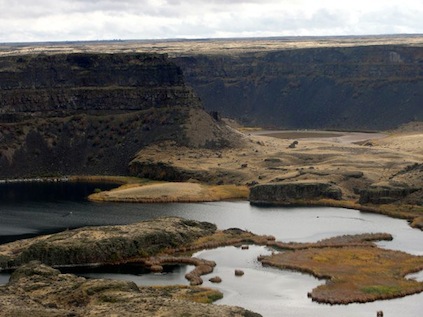The Earth is a wonderful storyteller.
When we spent our first summer in Eastern Washington, I became absolutely fascinated by the diverse geology of our new locale. We live in an area that, 250 million years ago, was under the Pacific Ocean, though not far from the coastline — at that time, roughly the border between present-day Washington and Idaho.
It’s also an area that, 17 to 6 million years ago, saw thousands of years of lava flows pouring over it.
And, during the most recent Ice Age, advancing glacial ice resulted in  cataclysmic flooding that formed gigantic, deep lakes and resulted in many of the geological formations that exist today, such as Dry Falls, pictured at right.
cataclysmic flooding that formed gigantic, deep lakes and resulted in many of the geological formations that exist today, such as Dry Falls, pictured at right.
I stand in awe of dramatic stories that unfolded long before the human story began.
The Earth tells her stories through what has been left behind after these dramatic events. The stories of undersea existence, volcanic activity, glacial flooding, and more are told all at once and in a nonlinear fashion. In our area, we can see the legacy of glacial lakes from 10,000 years ago and then travel a few miles to see volcanic evidence from a much earlier era. And the story continues as the earth continues to evolve. Volcanoes erupt. Tectonic plates clash. Floods and landslides change the landscape.
A week ago, I went on a geology field trip led annually by a local geologist. As fascinating as it was, much of the science went over my head; I wish our leader had been a bit better as a storyteller. Some scientists are brilliant storytellers who facilitate the layperson’s understanding. Our leader wasn’t awful, but I wish I could have grasped more of the story.
I was so fascinated by my area’s geology when we spent our first summer here in 2009 that I bought several books on the geological history of the region. But like the field-trip leader, they didn’t tell the Earth’s story in a very accessible way. The best, most storied, easiest-to-understand resource I found turned out to be a free 14-page booklet I picked up from the National Park Service.
Despite my struggle to fully understand the story, I’ll continue to study it. The field-trip geologist said the trip route he’s considering next year includes geological phenomena that are more a billion years old.
Can you imagine?
